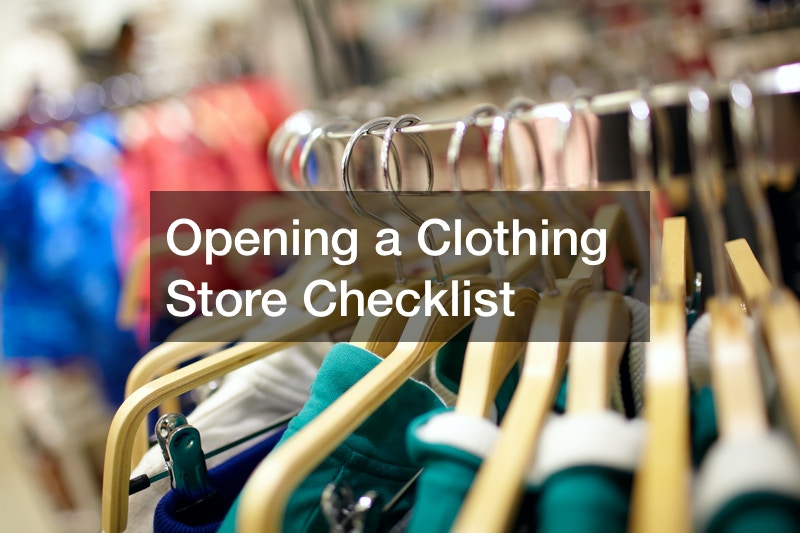
Discovering the desire to start a clothing store is the first step in opening up a clothing business. Knowing tips on opening a clothing store checklist will ensure that you accomplish your goals and succeed in your business venture.
Owning your clothing boutique can be extremely rewarding, but the hard work of making it successful takes lots of planning and inspiration. Hiring a roofer, for instance, will help you make any necessary repairs on your roofing structure to increase the curb appeal of your store. Renovating your store can give you a fresh start to make an even better impression on customers.
One of the tips for opening a clothing store checklist is to choose a name for your store. The business name is your first opportunity to set yourself apart from your competitors, so you must take plenty of time to decide on the right name for your clothing store. It should immediately convey the image you are trying to project with your products, be easy to spell and remember, and not infringe upon copyrighted names or trademarks. You may want to hire an attorney to search for local laws before settling on a final list of potential business names to avoid infringing upon existing brands.
When opening a clothing store, there is a lot that has to be considered. In opening a clothing store checklist, one of those things to consider is the look and feel of the space being used. Having good displays and fitting rooms can greatly impact how customers perceive what you have to offer.
If your target clients think that the clothes will fit properly, they will be more likely to purchase something, which every business owner wants. Having better racks, lighting, and dressing rooms can improve these aspects of your store, leading to an increase in sales. Getting a small business loan can help with this and renovation ideas for your new clothing store.
Some other elements of opening a clothing store checklist include:
Location, Location, Location
As with any business, location is of the utmost importance in opening a clothing store checklist. You have multiple options when it comes to choosing your location for an apparel store, including strip malls, standalone buildings, street-facing storefronts, or non-retail space such as office spaces or warehouses where you can sell wholesale items on consignment.
Your choice depends entirely on your budget and on how attractive you want your storefront to be to customers. Researching about the competitors in the area is an important tip for opening a clothing store checklist. A key consideration is whether other stores are selling similar products nearby, which could provide enough foot traffic for both businesses to survive independently.
Knowing your competitors inside and out is essential to opening an apparel store successfully. Visit the stores that are comparable to your own, take notes on their location, pricing structure, display arrangements, merchandise assortment, and clientele demographics. Make sure you set yourself apart from these competitors with something unique, such as trendier merchandise or a more efficient glass company. Commercial paving contractors may be of significant help in increasing the curb appeal of your outdoor space.
Before opening a clothing store, one should determine if they would like to build or find an existing building that might work well for their needs. If someone decides to build their store, there are many factors to consider, such as location, size of the building, number of parking spaces needed for customers and employees, available utilities set up at the site, etc. These decisions must all be made before construction can begin, so it is important to take your time when making this decision.
For those looking to purchase an existing building instead of constructing their own, several factors need to be considered, including location, how accessible it is to customers, size of a store must have enough space for the number of products being sold, dressing rooms, and fitting rooms, utilities available at the site, condition of the building structure, cost to purchase the property and renovations needed.
Another important aspect of opening a clothing store checklist is ensuring you have a good lock in place. With this, you need to consider working with a reputal commercial locksmith service to ensure your store is not easily accessible by unwanted persons.

Make Sure You Have Enough Space
When renovating your boutique space, determine what is needed by how many people will be shopping there. If you have ten employees, then ten people should fit in the dressing room at once. However, if you are expecting 20 or more shoppers to come through per hour on certain days, then opt for 17-20 feet of open floor space instead so they can easily mingle around.
Be sure all the lighting is proper to ensure your customers can see the clothing, and if you’re using natural light, make sure there are no dark corners or else it will appear gloomy. Also, remember that you should paint the walls a smooth color like eggshell white or another neutral hue that works well with all clothing colors.
Add higher ceiling shelves to your store to maximize your retail space and storage area if space allows. This way, you will not have to rent extra warehouse space somewhere else. You will also show off more items on the floor level if you do not want them out where everyone can get at them! Elevate different displayed items by adding boxes and crates with wrought iron detailing for an added touch of classiness.
Clothing can come in all shapes, sizes, and colors; do not mistake putting everything out on racks where customers will never be able to see it properly. Hanging shirts, pants, and dresses with uniform hangers will help you save space by stacking more clothes on fewer racks.
For a more stylish look, mix items, so it does not look too uniform. You can also let clothing hang over the front of a lower rack for a cascading effect. Finally, adding a mirror near your racks so people can check themselves out before they leave is always nice!

Obtain Business Licenses and Permits
Business licenses and permits are crucial factors in opening a clothing store checklist. Before you sign a lease or purchase inventory, you must apply for the business licenses and permits required by the local government agencies to start doing business legally.
The necessary documents can vary based on your location, so check with the Chamber of Commerce or city hall where you intend to open a shop for detailed instructions. The clothes you wear say a lot about you. They can reflect your personality, current trends, likes, and dislikes. However, before you start shopping for pieces to fill out your new wardrobe, make sure that business licenses and permits are not standing in your way of the shop opening up.
Observing city-specific ordinances requires research on the specific rules and regulations listed under the city’s ordinances. In some regions, it is compulsory to install a fire suppression system. It would help if you did thorough research to ensure you meet all the requirements of opening a clothing store checklist. However, it is always a good idea to contact a trusted economic development source or local government official before opening up a business to find out if permits are required.
In general, any commercial enterprise may need to acquire licenses and permits from several agencies. These business licenses and permits are required by the state, county, or city regulatory agencies. Examples are zoning approvals for certain types of businesses typically located in specific areas or sign permit applications that allow signage to be displayed at the location.
Before engaging a sign or printing company among other service providers for the clothing store, ensure you have met all the required business licensing and permits. This includes any outdoor and indoor signs, which could include neon lighting displays, open sign faces on vending machines, closed-circuit TVs displaying advertising messages, etc.

First Impressions Last
Another tip on opening a clothing store checklist is that you must have some inventory on hand before you open your doors for business or engage commercial movers in transferring your stuff to the store. Look around online for distributors who can provide you with a steady stream of inventory. Keep in mind that many clothing retailers have multiple vendors to offer a diverse assortment for their customers.
You can design your store layout or hire a professional interior designer to set up attractive displays that attract customers and make the best use of available retail space. Opening a clothing store can be an exciting and profitable business, but this type of venture does take time and plenty of planning. To be successful in this business, you need to know your strengths and weaknesses.
To succeed, a business needs to be visible and accessible. In an area packed with shops, a clothing store takes a lot of work to stand out from the crowd. Luckily, there are plenty of ways that stores can attract customers without going broke in the process. A well-organized window display is vital to attract walk-in customers.
If you have already got mannequins in place, consider using them as part of your display. Swap dresses and skirts on their displays for gifts or seasonal items like summer hats when the weather gets warmer. For added effect, add seasonal wreaths and garlands to the window frame.
An inviting entrance is one of the things in opening a clothing store checklist that you should never forget. If you want passersby to come in, make sure your fashion boutique’s door is easy to spot. Paint an eye-catching mural next to it with a graphic like polka dots or stripes. When you are hiring staff, consider selecting employees who look friendly and approachable. Also, consider adding planters or hanging baskets of bright flowers by your store’s entrance for an increased curb appeal and a warm welcome!

Look For Suppliers
Fashion industry manufacturers are usually based in major fashion capitals like New York, London, or Milan, so it might be best to locate them on a map before you approach them about setting up an account. Many clothing retailers choose to work with wholesalers who buy large quantities of merchandise directly from designers and then resell it to customers at discounted prices. You may even find companies that offer consignment services, allowing you to sell other people’s products in your store until they are sold, rather than purchase goods upfront.
Once all of these steps before opening a clothing store checklist have been completed and passed successfully, one will need to handle various logistical tasks such as ordering merchandise and preparing marketing materials, signage, logos, website content. These tasks should also include contacting suppliers for bulk orders at wholesale prices to ensure you are getting the best deals possible.
Instead of lining the walls with racks and racks of designer clothes, opt for dressing tables instead for those who want to try things on. This allows everyone to get creative with their outfits while you are still able to offer a wide range of price points for shoppers! Make sure that your fashion clothing store has enough variety at each price point so that everyone can find something within their budget.
Focus on selling quality over quantity when it comes to space in your shop. Rather than trying to cram everything in, take advantage of every inch of floor space by utilizing creative displays and fixtures so that there’s room for shoppers’ creative exploration. Do not forget about storage!
Think about how you can use these spaces more efficiently with fitting rooms, dressing tables, drawers, racks, and shelves. Think about how you can use these spaces more efficiently. You do not have to be an expert in warehouse management, but incorporating smart design into your store layout will result in better-stocked displays, shorter queues, and more room for customers to try on. With the help of a metal fabricator, one can easily divide the store into various sections to use in storage and displaying of your clothes for sale.
Inventory is a major expenditure, so it is important to have solid numbers before making any purchases. The retail price should be the highest possible price the target market will pay without leaving empty-handed. Remember that retailers need a profit margin, so adding a percentage on top of the cost will leave you with a good selling point.
Startups can afford lower margins than established businesses because they have l8ess overhead costs and more flexibility to maneuver if something goes wrong. The business plan needs to include all pertinent information such as monthly sales targets and what factors might affect those targets. For these figures to be accurate, it is better not to give out discount coupons too early in the beginning stages.
Opening a clothing store checklist should also entail sprucing up your business space. You can decorate the space with artwork. A sign company can easily make you design a board to hang paintings or pictures that reflect your clothing. You can also keep sculptures or antique items to add a classy feel.
Either way, furnishing the store with pieces that look great while showcasing your merchandise will help boost sales. Do not let fear stop you from doing something that you have always dreamed of doing. With the help of the electrical contractor, electrical installation and electrical repairs will be much easier than ever before!
Do not be afraid to invest in your store. When it comes down to it, if you do not invest in your boutique by keeping up with trends and adding new stock regularly, then all of your hard work renovating goes out the window. Customers want fresh styles every season, so they will always come back for more!



